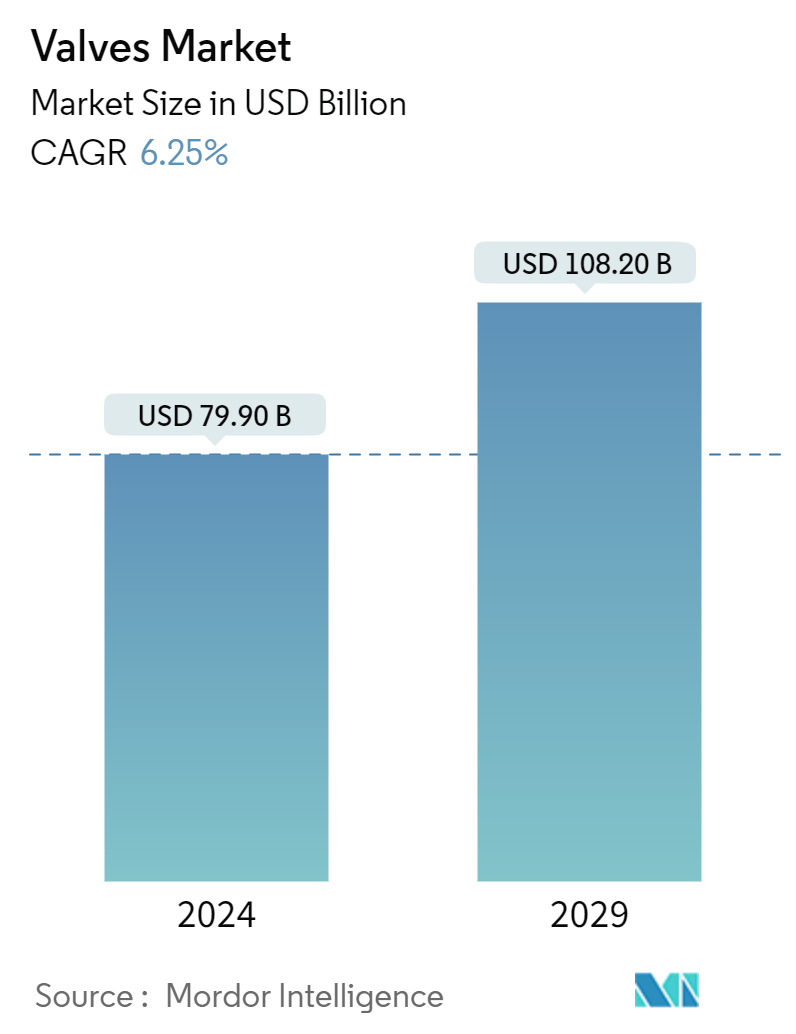Market Size of Valves Industry

| Study Period | 2021 - 2029 |
| Market Size (2024) | USD 79.90 Billion |
| Market Size (2029) | USD 108.20 Billion |
| CAGR (2024 - 2029) | 6.25 % |
| Fastest Growing Market | Asia-Pacific |
| Largest Market | Asia-Pacific |
Major Players
*Disclaimer: Major Players sorted in no particular order |
Need a report that reflects how COVID-19 has impacted this market and its growth?
Valves Market Analysis
The Valves Market size is estimated at USD 79.90 billion in 2024, and is expected to reach USD 108.20 billion by 2029, growing at a CAGR of 6.25% during the forecast period (2024-2029).
• Valves control the flow and pressure within a system or process. It forms an essential piping system component that conveys liquids, gases, vapors, slurries, etc. Hence, the growing investment in infrastructure development and the automation of industries are driving the growth of the studied market. Rising investments in pipeline infrastructure in the oil and gas sector are expected to boost the installation of industrial valves.
• Additionally, many developing countries are witnessing increased government water supply and sanitation projects, which will likely propel the sales of industrial valves for domestic and agricultural applications. Furthermore, the growth in investments made by various countries to develop the water and wastewater infrastructure is another major factor driving the studied market's growth, as valves are widely used in water and wastewater plants and distribution pipelines. The global valve market has many players offering various solutions targeting applications across various end-user industries. This significantly drives competition among the vendors, encouraging them to develop innovative solutions and adopt unique business strategies to expand their market presence. Hence, the growing market competitiveness is anticipated to drive the studied market's growth further during the forecast period.
• Many companies are leveraging emerging technologies such as artificial intelligence (AI) and industrial Internet of Things (IIoT) to minimize unplanned downtime and other unfavorable incidents due to valve failures. Valves equipped with sensors are also being increasingly adopted to reduce failures and overall maintenance costs. The adoption of these advanced values is expected to boost the market further over the forecast period.
• However, the market players need to comply with the various certifications and policies of different regions concerning valve manufacturing, resulting in diversity in product specifications due to the widespread application of valves in several end-user industries. This acts as a restraint for market growth as the companies have to manufacture products according to the regional policies, making it difficult for them to achieve an ideal installation cost.
• The COVID-19 pandemic had a negative impact on the oil and gas industry, with oil prices slashing drastically. The decline in the demand for oil and gas due to various restrictions imposed by governments worldwide created a huge gap between supply and demand. Besides oil and gas, water and wastewater treatment and energy and power industries are also among the key end-users of valves. All these industries also witnessed reduced demand due to the global pandemic. However, with the restrictions lifted from almost everywhere, these industries have started recovering gradually in the post-pandemic period, accelerating the market growth going forward during the forecast period.

